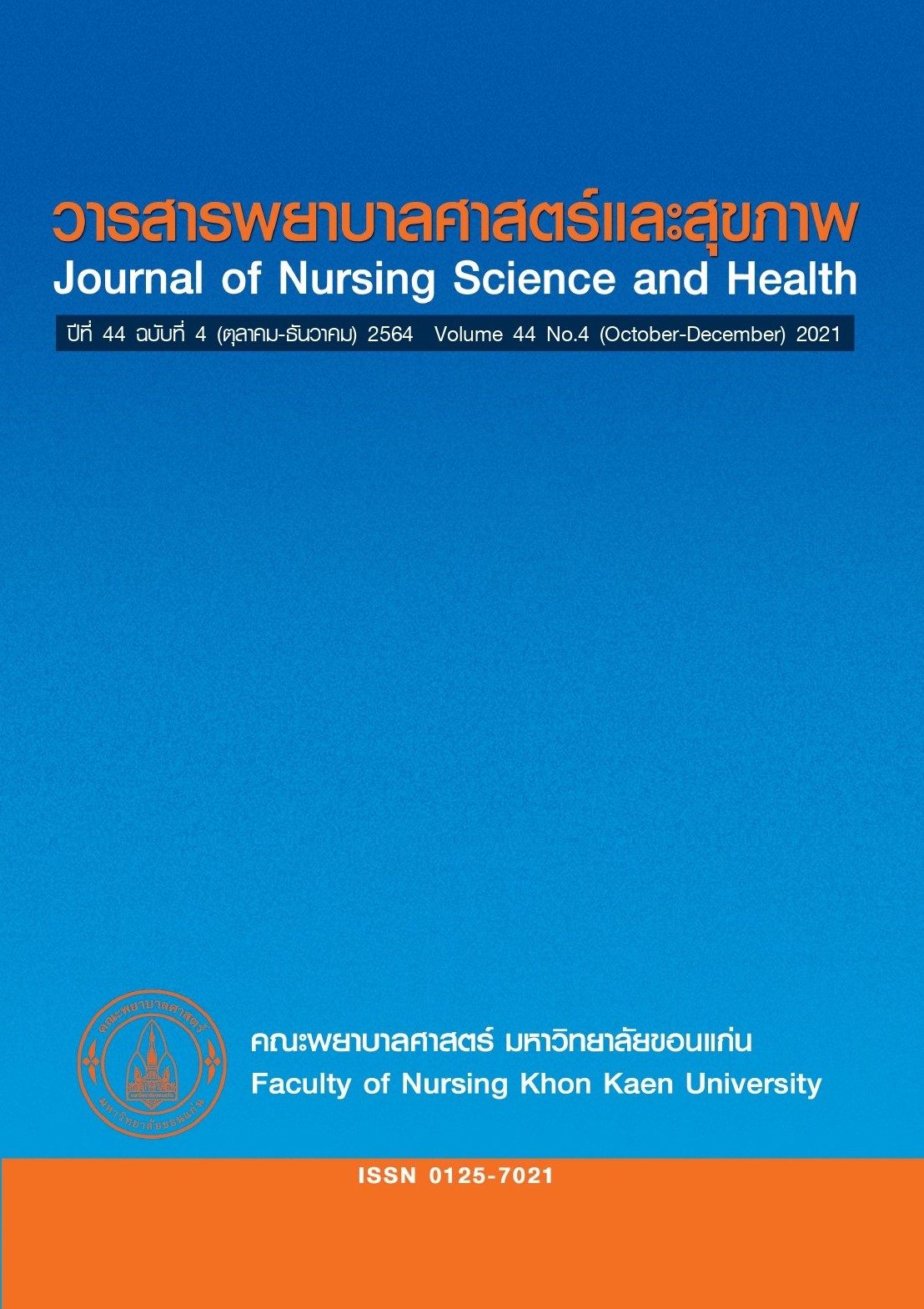ผลของโปรแกรมการพัฒนาความรอบรู้ด้านสุขภาพร่วมกับแรงสนับสนุนทางสังคม ต่อการปฏิบัติตัวและระดับฮีมาโตคริตของหญิงตั้งครรภ์ที่มีภาวะโลหิตจางจากการขาดธาตุเหล็ก
คำสำคัญ:
หญิงตั้งครรภ์, ภาวะโลหิตจางจากการขาดธาตุเหล็ก, ความรอบรู้ด้านสุขภาพ, แรงสนับสนุนทางสังคมบทคัดย่อ
การวิจัยกึ่งทดลองนี้มีวัตถุประสงค์เพื่อศึกษาผลของโปรแกรมการพัฒนาความรอบรู้ด้านสุขภาพร่วมกับแรงสนับสนุนทางสังคมต่อการปฏิบัติตัวและระดับฮีมาโตคริตของหญิงตั้งครรภ์ที่มีภาวะโลหิตจางจากการขาดธาตุเหล็ก กลุ่มตัวอย่างเป็นหญิงตั้งครรภ์ที่มีภาวะโลหิตจางระดับฮีมาโตคริต <33 เปอร์เซ็นต์ อายุครรภ์ระหว่าง 20 ถึง 26 สัปดาห์กลุ่มตัวอย่าง 60 คนแบ่งเป็นกลุ่มทดลอง 30 คน และกลุ่มควบคุม 30 คน กลุ่มทดลองได้รับโปรแกรมการพัฒนาความรอบรู้ด้านสุขภาพร่วมกับแรงสนับสนุนทางสังคมเป็นระยะเวลา 8 สัปดาห์โดยการมีส่วนร่วมของผู้ดูแล ประกอบด้วย 7 กิจกรรม ได้แก่1) มือใหม่มือเก่าเข้าถึงได้ 2)รู้ทันโลหิตจาง 3) การติดตามเยี่ยมทางไลน์ 4) คำถามนั้นสำคัญไฉน 5) บันทึกข้อตกลง 6) การติดตามเยี่ยมบ้าน และ 7) ประเมินความสำเร็จ โดยการให้ความรู้ผ่านสื่อวีดีทัศน์ฝึกทักษะความรอบรู้ด้านสุขภาพในการเข้าถึงเว็บไซต์ออนไลน์การลงแอปพลิเคชันด้วยตนเอง การอภิปรายกลุ่ม การประเมินความรู้การบันทึกลงนามไม่ลืมกินยาปฏิทินเตือนความจำและคู่มือในการปฏิบัติตัว โดยการมีส่วนร่วมของผู้ดูแลทุกกิจกรรม เป็นระยะเวลา 8 สัปดาห์ ส่วนกลุ่มควบคุมได้รับการฝากครรภ์ตามมาตรฐานการดำเนินงานตามปกติเก็บรวบรวมข้อมูลโดยใช้แบบสอบถามตอบด้วยตนเอง สถิติที่ใช้ในการวิเคราะห์ข้อมูล ได้แก่ ร้อยละ ค่าเฉลี่ย ส่วนเบี่ยงเบนมาตรฐาน ค่ามัธยฐานและพิสัยควอร์ไทล์เปรียบเทียบความแตกต่างค่าคะแนนเฉลี่ยภายในกลุ่มด้วยสถิติpaired t-test และสถิติ
wilcoxon match paired signed ranks test วิเคราะห์ความแตกต่างของคะแนนเฉลี่ยระหว่างกลุ่มทดลองและกลุ่ม
ควบคุมทั้งก่อนและหลังการทดลองด้วยสถิติindependent t-test และสถิติmann-whitneyutest กำหนดนัยสำคัญ
ทางสถิติที่ 0.05 และค่าความเชื่อมั่นที่ 95%
ผลการศึกษาพบว่า หลังการทดลองกลุ่มทดลองมีคะแนนเฉลี่ยความรอบรู้ด้านสุขภาพทั้ง 6 ด้านสูงกว่าก่อนทดลองและสูงกว่ากลุ่มควบคุมอย่างมีนัยสําคัญทางสถิติ(p-value<0.001) กลุ่มทดลองมีค่าเฉลี่ยคะแนน การปฏิบัติตัวเพื่อแก้ไขภาวะโลหิตจางจากการขาดธาตุเหล็กในหญิงตั้งครรภ์สูงกว่าก่อนทดลองอย่างมีนัยสําคัญ ทางสถิติ (t=9.37; p-value<0.001; 95%CI: 5.34-8.32) และสูงกว่ากลุ่มควบคุมอย่างมีนัยสําคัญทางสถิติ (t=7.29; p-value<0.001; 95% CI: 5.32-9.34) และกลุ่มทดลองมีค่ามัธยฐานระดับฮีมาโตคริตสูงกว่าก่อนทดลองและสูงกว่ากลุ่มควบคุมโดยมีค่ามัธยฐานระดับฮีมาโตคริตสูงขึ้นเท่ากับ 34.00 (พิสัยควอร์ไทล์ 2.0) อย่างมีนัยสําคัญทางสถิติ (p-value<0.001)
เอกสารอ้างอิง
World Health Organization. Anemia [Internet]. Geneva: World Health Organization; 2016 [cited 2020 Nov 20]. Available from: https://www. who.int/health-topics/anaemia# tab= tab_1
Khaskheli MN, Baloch MNS, Sheeba A, Baloch S, Khaskheli FK. Iron deficiency anaemia is still a major killer of pregnant women. Pakistan J Med Sci 2017; 32: 630-34.
World Health Organization. Prevalence of anaemia in pregnant women [Internet]. Geneva: World Health Organization; 2016 [cited 2020 Nov 20]. Available from: https:// www.who.int/data/gho/data/ indicators/ indicator-details/GHO/prevalence-of-anaemia -in-pregnant-women
Maternal and Child Health. Anemia in pregnant women reported. 2017-2019 (copydocuments). KhonKaen: KhonKaen Provincial Public Health Office; 2020. (in Thai)
Bureau of Policy and Strategy Ministry of Public Health. Indicators of the Ministry of public health [Internet]. Nonthaburi: Ministry of Public Health;2017 [cited 2020 Nov 20]. Available from: https://hdcservice.Moph. go.th/. (in Thai)
Institute for Population and Social Research Mahidol University. Buddhism and the health promotion [Internet]. Nakhon Pathom: Institute for Population and Social Research Mahidol University; 2018 [cited 2020 Jan 15]. Available from:https://www.hiso.or.th/hiso/picture/reportHealth/ThaiHealth2018/ thai2018_8.pdf. (in Thai)
Bureau of Nutrition Department of Health. Guideline the control and prevention of iron deficiency anemia [Internet]. Nonthaburi: Bureau of Nutrition; 2013 [cited 2020 Jan 15]. Available from: http://doh.hpc. go.th/data/mch/IDAControl.pdf. (in Thai)
Winichagoon P. Iron bioavailability. JNTA 2017; 52(1): 23-38. (in Thai)
Beckert RH, Baer RJ, Anderson JG, Jelliffe-Pawlowski LL, Rogers EE. Maternal anemia and pregnancy outcomes: A population-based study. TJOG 2019; 39: 911-9.
Scholl TO, Hediger ML. Anemia and iron-deficiency anemia: Compilation of data on pregnancy outcome. American Society for Clinical Nutrition 2016; 59(suppl): 492-501S.
Braymann C. Iron deficiency anemia in pregnancy. Semin Hematol 2018; 52: 339-47.
Asavaritikrai W, Pangbupha B, Aroonpacmongkol S. Effectiveness of management system of iron deficiency anemia in pregnancy: A study in affiliated hospitals of health promotion center region 4. Region 4-5 Medical Journal 2014; 33(4): 249-60. (in Thai)
Tachasuksri T, Siriarunrat S, Suppasri P, Suppaseemanont W, Boonnate N, Kwannate C, et al. Causal model for quality of life among pregnant women. SCNJ 2017; 4(1): 28-46 (in Thai)
Antenatal clinic and breast feeding clinic. Model for promoting health literacy about take iron supplement tabletsin pregnant women and lactating women [Internet]. Nakhon Sawan: Health Center 3 Nakhon Sawan; 2019 [cited 2020 Nov 20]. Available from: http://km.hpc3. org/wpfb. (in Thai)
TasharaI F, Achen RK, Quadras R, D’Souza MV, D’Souza PJJ, Sankar A. Knowledge and self-reported practices on prevention of iron deficiency anemia among women of reproductive age in rural area. IJASR 2015; 1(7): 289-92.
Thongwat N, Danpradit P, Ratchukul S. Iron deficiency anemia among completeattending ANC pregnant women: Aqualitative study. Journal of Nursing and Health Sciences2009; 3(3): 37-46. (in Thai)
Thongngern S, Kongkiat K, Duangchan A. Effects of caring for pregnant women at risk of preterm birth using a social support program in an antenatal clinic at Khuan Khanun Hospital [Internet]. Phatthalung: KhuanKhanun Hospital; 2017 [cited 2020 Nov 15]. Available from: http:// 203.157.229.18/ptvichakarn61/uploads/ 51815_0702_20180604163543_pdf. (in Thai)
SaranrittichaiK. Health literacy: Concepts, theories and applications. KhonKhean: Klungnanavitthaya press; 2020. (in Thai)
Solhi M, Abbasi K, Azar FEF, Hosseini A. Effect of health literacy education on self-care in pregnant women: A randomized controlled clinical trial. IJCBNM 2019;7(1):1-12.
Health Education Division Department of health service support Ministry of Public Health. Health literacy [Internet]. Nonthaburi: Health Education Division; 2011 [cited 2020 Oct 2]. Available from: http://www.hed.go.th/linkHed/69. (in Thai)
House JS. Work stress and social support. Califonia: Addison Wesley; 1981.
Chirawatkul A. Statistics for health science research 4th ed. KhonKhean: Klungnanavitthaya press; 2007. (in Thai)
Boonyaprapapan T, Sangin S, Siriarunrat S. Effects of the educative supportive program on self-care behavior and hematocrit level among pregnant women with iron deficiency anemia. JFONUBUU 2018; 26(4): 40-50. (in Thai)
Intarakamhang U. Creation and development of Thailand health literacy [Internet]. Bangkok: The Behavioral Science Research Institute; 2017 [cited 2020 Jan 15]. Available from: http://bsris.swu.ac.th/upload/ 268335.pdf. (in Thai)
Kohan S, Ghasemi S, Dodangeh M. Associations between maternal health literacy and prenatal care and pregnancy outcome. IJNMR 2007; 12(4): 146-52.
Waraphok S, Ratinthorn A, Limruangrong P. Factors influencing maternal health literacy in pregnant women. JTNMC 2020; 35(1): 86-98. (in Thai)
Pinchaleaw D. Nurses and management of iron deficiency anemia in pregnant women. JOPN 2017; 9(2): 195-202. (in Thai)
ดาวน์โหลด
เผยแพร่แล้ว
รูปแบบการอ้างอิง
ฉบับ
ประเภทบทความ
สัญญาอนุญาต
วารสารพยาบาลศาสตร์และสุขภาพเป็นเจ้าของลิขสิทธิ์ในการเผยแพร่ผลงานที่ตีพิมพ์ห้ามผู้ใดนำบทความที่ได้รับการตีพิมพ์ในวารสารพยาบาลศาสตร์และสุขภาพไปเผยแพร่ในลักษณะต่าง ๆ ดังนี้ การนำบทความไปเผยแพร่ออนไลน์ การถ่ายเอกสารบทความเพื่อกิจกรรมที่ไม่ใช่การเรียนการสอน การส่งบทความไปตีพิมพ์เผยแพร่ที่อื่น ยกเว้นเสียแต่ได้รับอนุญาตจากวารสารพยาบาลศาสตร์และสุขภาพ



